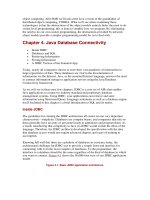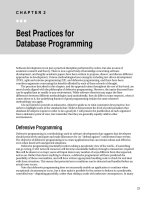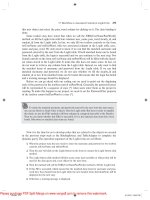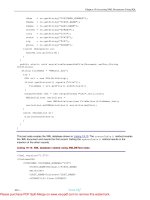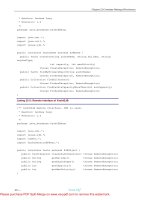Java Database Programming Bible- P8
Bạn đang xem bản rút gọn của tài liệu. Xem và tải ngay bản đầy đủ của tài liệu tại đây (780.35 KB, 50 trang )
Chapter 1 3:Using PreparedStatements and CallableStatements
-350-
<OPTION value=IL>Illinois</OPTION>
<OPTION value=IN>Indiana</OPTION>
<OPTION value=KS>Kansas</OPTION>
<OPTION value=KY>Kentucky</OPTION>
<OPTION value=LA>Louisiana</OPTION>
<OPTION value=MA>Massachusetts</OPTION>
<OPTION value=MB>Manitoba</OPTION>
<OPTION value=MD>Maryland</OPTION>
<OPTION value=ME>Maine</OPTION>
<OPTION value=MI>Michigan</OPTION>
<OPTION value=MN>Minnesota</OPTION>
<OPTION value=MO>Missouri</OPTION>
<OPTION value=MS>Mississippi</OPTION>
<OPTION value=MT>Montana</OPTION>
<OPTION value=NB>New Brunswick</OPTION>
<OPTION value=NC>North Carolina</OPTION>
<OPTION value=ND>North Dakota</OPTION>
<OPTION value=NE>Nebraska</OPTION>
<OPTION value=NF>Newfoundland</OPTION>
<OPTION value=NH>New Hampshire</OPTION>
<OPTION value=NJ>New Jersey</OPTION>
<OPTION value=NM>New Mexico</OPTION>
<OPTION value=NS>Nova Scotia</OPTION>
<OPTION value=NT>Northwest Territories</OPTION>
<OPTION value=NV>Nevada</OPTION>
<OPTION value=NY>New York</OPTION>
<OPTION value=OH>Ohio</OPTION>
<OPTION value=OK>Oklahoma</OPTION>
<OPTION value=ON>Ontario</OPTION>
<OPTION value=OR>Oregon</OPTION>
<OPTION value=PA>Pennsylvania</OPTION>
<OPTION value=PE>Prince Edward Island</OPTION>
<OPTION value=QC>Quebec</OPTION>
<OPTION value=RI>Rhode Island</OPTION>
<OPTION value=SC>South Carolina</OPTION>
<OPTION value=SD>South Dakota</OPTION>
<OPTION value=SK>Saskatchewan</OPTION>
<OPTION value=TN>Tennessee</OPTION>
<OPTION value=TX>Texas</OPTION>
<OPTION value=UT>Utah</OPTION>
<OPTION value=VA>Virginia</OPTION>
<OPTION value=VT>Vermont</OPTION>
<OPTION value=WA>Washington</OPTION>
TEAMFLY
Team-Fly
®
Please purchase PDF Split-Merge on www.verypdf.com to remove this watermark.
Chapter 1 3:Using PreparedStatements and CallableStatements
-351 -
<OPTION value=WI>Wisconsin</OPTION>
<OPTION value=WV>West Virginia</OPTION>
<OPTION value=WY>Wyoming</OPTION>
<OPTION value=YK>Yukon</OPTION>
</SELECT>
</TD>
<TD height=49 vAlign=bottom width=158>
Zip/Postal code<BR><INPUT name=Zip size=15>
</TD>
</TR>
</TBODY>
</TABLE>
</TD>
</TR>
<TR>
<TD align=center>
<BR/>
<INPUT name=SubmitButton type=SUBMIT value="Click here to
proceed">
<BR/>
<P/>
</TD>
</TR>
</TABLE>
</TD>
</TR>
</TABLE>
</FORM>
</BODY>
</HTML>
After local validation by the JavaScript, the form data is passed to the JSP page ProcessNAForm.jsp,
which uses the ProcessNABean to insert the form data into the database. ProcessNAForm.jsp is a
simple example of a JSP form handler. It loads the ProcessNABean and sets its properties using the
wild card property setter that relies on introspection to set all the properties of the JavaBean from the
form data. When the insertData() method is called, ProcessNABean returns a boolean which is
used to set the String nextPage to the appropriate handler. Finally, the <jsp:forward> tag is
used to forward the user to the appropriate page. Listing 13-6 shows the JSP page.
Listing 13-6: ProcessNAForm.jsp
<%@ page language="java"%>
<jsp:useBean id="ProcessNABean"
class="JavaDatabaseBible.ch13.ProcessNABean" scope="session"/>
<jsp:setProperty name="ProcessNABean" property="*"/>
<%
Please purchase PDF Split-Merge on www.verypdf.com to remove this watermark.
Chapter 1 3:Using PreparedStatements and CallableStatements
-352 -
String nextPage = "MemberWelcome.jsp";
if(ProcessNABean.insertData()){
nextPage = "MemberProfile.jsp";
}else{
nextPage = "NewMemberForm.jsp";
}
%>
<jsp:forward page="<%=nextPage%>"/>
Operation of the ProcessNABean
The first part of the ProcessNABean is the collection of getter and setter methods required to access
the bean's parameters. These must be supplied for the bean introspection that the JSP engine requires
to work properly.
The real work is done in the insertData() method. The ProcessNABean makes extensive use of a
CallableStatement object, cs. First it calls the stored procedure GET_LOGIN_FOR_USER to validate
the username against the Login table. If the username is already in use, the boolean flag
username_selection_ok is set to false so that the JSP page can notify the user that he or she
needs to select a different username.
Once the user has selected a valid, unique username, the CallableStatement object is used to call
the stored procedure SET_LOGIN_FOR_USER to update the Login table with the new username and
password. The stored procedure SET_LOGIN_FOR_USER is defined as follows:
CREATE PROCEDURE SET_LOGIN_FOR_USER
@USERNAME VARCHAR(20),
@PASSWORD VARCHAR(20)
AS
INSERT INTO LOGIN (USERNAME, PASSWORD)
VALUES (@USERNAME, @PASSWORD);
The stored procedure GET_LOGIN_FOR_USER is then called again to get the auto generated MemberID
assigned to this user. A more elegant way to do this is to use the getGeneratedKeys() method
defined in JDBC 3.0 for the Statement object as shown here:
if(cs.executeUpdate()!=1)ok = false;
Result rs = cs.getGeneratedKeys();
Cross-
Reference
The use of the JDBC 3.0 extension method
Statement.getGeneratedKeys() is discussed in Chapter 4.
Finally, the stored procedure INSERT_CONTACT_INFO is called to insert the member data stored in
the ProcessNABean.
The code for the ProcessNABean is shown in Listing 13-7.
Listing 13-7: Calling a stored procedure from a JavaBean
package JavaDatabaseBible.ch13;
import java.sql.*;
import javax.sql.*;
Please purchase PDF Split-Merge on www.verypdf.com to remove this watermark.
Chapter 1 3:Using PreparedStatements and CallableStatements
-353 -
public class ProcessNABean extends java.lang.Object{
private static String dbUserName = "sa";
private static String dbPassword = "dba";
protected String firstName;
protected String lastName;
protected char mi;
protected String street;
protected String city;
protected String state;
protected String zip;
protected String phone;
protected String email;
protected String username;
protected String password;
public ProcessNABean(){
}
public void setUsername(String username){
this.username = username;
}
public void setPassword(String password){
this.password = password;
}
public void setFirstName(String firstName){
this.firstName = firstName;
}
public void setLastName(String lastName){
this.lastName = lastName;
}
public void setMi(char mi){
this.mi= mi;
}
public void setStreet(String street){
this.street = street;
}
public void setCity(String city){
this.city = city;
}
public void setState(String state){
this.state = state;
}
Please purchase PDF Split-Merge on www.verypdf.com to remove this watermark.
Chapter 1 3:Using PreparedStatements and CallableStatements
-354 -
public void setZip(String zip){
this.zip = zip;
}
public void setPhone(String phone){
this.phone = phone;
}
public void setEmail(String email){
this.email = email;
}
public String getUsername(){
return username;
}
public String getPassword(){
return password;
}
public String getFirstName(){
return firstName;
}
public String getLastName(){
return lastName;
}
public char getMi(){
return mi;
}
public String getStreet(){
return street;
}
public String getCity(){
return city;
}
public String getState(){
return state;
}
public String getZip(){
return zip;
}
public String getPhone(){
return phone;
}
public String getEmail(){
return email;
}
public boolean insertData(){
Please purchase PDF Split-Merge on www.verypdf.com to remove this watermark.
Chapter 1 3:Using PreparedStatements and CallableStatements
-355-
boolean username_selection_ok = true;
try {
Class.forName("com.inet.pool.PoolDriver");
com.inet.tds.TdsDataSource tds = new com.inet.tds.TdsDataSource();
tds.setServerName( "JUPITER" );
tds.setDatabaseName( "MEMBERS" );
tds.setUser( dbUserName );
tds.setPassword( dbPassword );
DataSource ds = tds;
Connection con = ds.getConnection(dbUserName,dbPassword);
CallableStatement cs = con.prepareCall("{call
GET_LOGIN_FOR_USER(?)}");
cs.setString(1,username);
ResultSet rs = cs.executeQuery();
ResultSetMetaData md = rs.getMetaData();
int id = -1;
while(rs.next()){
id = rs.getInt("MemberID");
}
if(id>=0){
System.out.println(id+": "+username+"; "+password);
username_selection_ok = false;
}else{
cs = con.prepareCall("{call SET_LOGIN_FOR_USER(?,?)}");
cs.setString(1,username);
cs.setString(2,password);
if(cs.executeUpdate()!=1) username_selection_ok = false;
cs = con.prepareCall("{call GET_LOGIN_FOR_USER(?)}");
cs.setString(1,username);
rs = cs.executeQuery();
while(rs.next()){
id = rs.getInt("MemberID");
}
cs = con.prepareCall("{call
Please purchase PDF Split-Merge on www.verypdf.com to remove this watermark.
Chapter 1 3:Using PreparedStatements and CallableStatements
-356 -
INSERT_CONTACT_INFO(?,?,?,?,?,?,?,?,?,?)}");
cs.setInt(1,id);
cs.setString(2,firstName);
cs.setString(3,String.valueOf(mi));
cs.setString(4,lastName);
cs.setString(5,street);
cs.setString(6,city);
cs.setString(7,state);
cs.setString(8,zip);
cs.setString(9,"<NULL>");
cs.setString(10,email);
if(cs.executeUpdate()!=1) username_selection_ok = false;
}
}catch(ClassNotFoundException e1){
System.err.println(e1.getMessage());
}catch(SQLException e2){
System.err.println(e2.getMessage());
}
return username_selection_ok;
}
}
Error Handling
Recall that the ProcessNABean notifies the ProcessNAForm.jsp page that the user needs to select
a different username by setting the boolean flag username_selection_ok to false. This lets the
ProcessNAForm.jsp know that a problem has arisen, so it then sends the user back to the form so he
or she can select a new username and password.
As it stands, the form is cleared when redisplayed. This is virtually guaranteed to ensure that the user
gets fed up and surfs on. The way to avoid this is to fill in the fields the user has already completed and
to present a message telling him or her what to do next.
One of the primary uses of JavaBeans in JSP applications is data storage. Since all the form data has
already been inserted into the ProcessNABean, completing the form for the user requires only the
addition of this line:
<jsp:useBean id="ProcessNABean".../>
Also, include these few extra lines of code to set the properties:
First Name<BR><INPUT maxLength=30 name=firstName
value='<jsp:getProperty name="ProcessNABean" property="firstName"/>'
size=26>
A partial listing of the modified form is shown in Listing 13-8.
Listing 13-8: ProcessNAForm.jsp modified for use as an error page
Please purchase PDF Split-Merge on www.verypdf.com to remove this watermark.
Chapter 1 3:Using PreparedStatements and CallableStatements
-357 -
<!DOCTYPE HTML PUBLIC "-//W3C//DTD HTML 4.0 Transitional//EN">
<HTML>
<HEAD>
<TITLE>
Member Registration
</TITLE>
<SCRIPT language=JavaScript1.1 >
function validate(form){
if( form.elements["firstName"].value==" "||
form.elements["lastName"].value=="" ||
form.elements["email"].value=="" ||
form.elements["city"].value=="" ||
form.elements["state"].value=="?"||
form.elements["zip"].value=="" ){
alert("Please enter first name, last name, email, city, state and
zip.");
return false;
}
return true;
}
</SCRIPT>
<META content="text/html; charset=windows-1252" http-equiv=Content-Type>
</HEAD>
<BODY bgColor=#ffffff>
<BASEFONT face=Arial size=3>
<%@ page session="true" %>
<jsp:useBean id="ProcessNABean"
class="JavaDatabaseBible.ch13.ProcessNABean" scope="session"/>
<FORM action=ProcessNAForm.jsp method=POST target=_self
onSubmit="return validate(this);">
<TABLE cellPadding=0 BORDER=0>
<TR>
<TD>
<TABLE cellPadding=0 BORDER=1>
<TR>
<TD valign=center>
</P>
<SMALL>
<CENTER>
<FONT color=#ff0000>
Please purchase PDF Split-Merge on www.verypdf.com to remove this watermark.
Chapter 1 3:Using PreparedStatements and CallableStatements
-358-
Information contained in the shaded portion of this page will
be kept
confidential
</FONT>
</CENTER>
<SMALL>
</TD>
</TR>
<TR>
<TD>
<TABLE cellPadding=4 cellSpacing=0 Border=0 BGCOLOR="#AAAAAA"
WIDTH="100%">
<TBODY>
<TR>
<TD vAlign=bottom>
<TABLE cellSpacing=0 cellPadding=0 Border=0>
<TR>
<TD>
First Name<BR><INPUT maxLength=30 name=firstName
value=
'<jsp:getProperty name="ProcessNABean"
property="firstName"/>'
size=26>
</TD>
<TD vAlign=bottom align=right>
M.I.<BR><INPUT maxLength=1 name=mi value=
'<jsp:getProperty name="ProcessNABean"
property="mi"/>'size=2>
</TD>
</TR>
</TABLE>
</TD>
<TD vAlign=bottom>
Last Name<BR><INPUT maxLength=30 name=lastName
value='<jsp:getProperty name="ProcessNABean"
property="lastName"/>
'size=30>
</TD>
</TR>
<TR>
<TD vAlign=bottom>
Choose a User Name<BR><INPUT maxLength=30 name=username
value=
Please purchase PDF Split-Merge on www.verypdf.com to remove this watermark.
Chapter 1 3:Using PreparedStatements and CallableStatements
-359 -
'<jsp:getProperty name="ProcessNABean"
property="username"/>'
size=30>
</TD>
<TD height=43 colspan=2 vAlign=bottom>
Choose a password<BR><INPUT name=password size=20>
</TD>
</TR>
<TR>
<TD vAlign=bottom>
EMail Address<BR><INPUT maxLength=30 name=email
value='<jsp:getProperty name="ProcessNABean"
property="email"/>'
size=30>
</TD>
</TR>
<TR>
<TD height=43 vAlign=bottom>
Street Address<BR><INPUT name=street
value=
'<jsp:getProperty name="ProcessNABean"
property="street"/>'
size=30>
</TD>
</TR>
</TBODY>
</TABLE>
</TD>
</TR>
Note
Listing 13-8 is only partial, showing the basic workings of the JSP page. Substitute this
into Listing 13-5, and implement the additional lines for the remaining properties to
create a complete form.
Figure 13-2 shows the use of the original form as a means of providing interactive feedback to the user.
This kind of user feedback is important in terms of ensuring that a user will take the trouble to complete
a form instead of simply surfing on.
Please purchase PDF Split-Merge on www.verypdf.com to remove this watermark.
Chapter 1 3:Using PreparedStatements and CallableStatements
-360-
Figure 13-2: Member-registration form with user data restored and error message displayed for
user name
Using Stored Procedures with Input and Output Parameters
In addition to supplying input parameters to a stored procedure, you can get output parameters from a
stored procedure. If you decide to use an output parameter, it must be registered as an OUT parameter
using the CallableStatement.registerOutParameter() method before the execute method is
called. Here's an example:
cstmt.registerOutParameter(1, java.sql.Types.VARCHAR);
OUT parameter values can be retrieved after execution using get methods appropriate to the data types
of the values. Because of limitations some relational database management systems impose, all of the
results the execution generates of a CallableStatement object should be retrieved before OUT
parameters are retrieved.
Listing 13-9 gives an example of a simple stored procedure that checks a user name and password
against the database, returning the String "PASS" if a match is found or "FAIL" otherwise.
Listing 13-9: Using an output parameter with a stored procedure
CREATE PROCEDURE CHECK_USER_NAME
@UserName varchar(30),
@Password varchar(20),
@PassFail varchar(20) OUTPUT
As
IF EXISTS(Select * From Login
Where UserName = @UserName
And
Password = @Password)
SELECT @PassFail = 'PASS'
else
SELECT @PassFail = 'FAIL';
Note
Stored procedures can contain more than one SQL statement, in which case they
produce multiple results, and the execute method should be used. In cases where a
CallableStatement object returns multiple ResultSet objects, all of the results
should be retrieved using the method getMoreResults before OUT parameters are
retrieved.
TEAMFLY
Team-Fly
®
Please purchase PDF Split-Merge on www.verypdf.com to remove this watermark.
Chapter 1 3:Using PreparedStatements and CallableStatements
-361 -
Listing 13-10 provides an example of using the simple stored procedure of Listing 13-9. Notice the call
to the registerOutParameter() method prior to calling the CallableStatement's getString
method to retrieve the output parameter.
Listing 13-10: Getting an output parameter from a stored procedure
package JavaDatabaseBible.ch13;
import java.sql.*;
import javax.sql.*;
public class CheckPassword{
private static String dbUserName = "sa";
private static String dbPassword = "dba";
public static void main(String args[]){
int id = -1;
String password = null;
String username = "";
if(args.length>0)username = args[0];
try {
Class.forName("com.inet.pool.PoolDriver");
com.inet.tds.TdsDataSource tds = new com.inet.tds.TdsDataSource();
tds.setServerName( "JUPITER" );
tds.setDatabaseName( "MEMBERS" );
tds.setUser( dbUserName );
tds.setPassword( dbPassword );
DataSource ds = tds;
Connection con = ds.getConnection(dbUserName,dbPassword);
CallableStatement cs = con.prepareCall("{call
CHECK_USER_NAME(?,?,?)}");
cs.setString(1,"garfield");
cs.setString(2,"lasagna");
cs.registerOutParameter(3, java.sql.Types.VARCHAR);
cs.executeUpdate();
System.out.println(cs.getString(3));
}
catch(ClassNotFoundException e){
e.printStackTrace();
}
catch(SQLException e){
e.printStackTrace();
Please purchase PDF Split-Merge on www.verypdf.com to remove this watermark.
Chapter 1 3:Using PreparedStatements and CallableStatements
-362-
}
}
}
Summary
This chapter discusses improving the efficiency of JDBC-based applications by comparing and
contrasting the three variations on the java.sql.Statement object:
§ java.sql.Statement, which performs in line execution of a SQL command. This approach is
ideal for one-shot execution of a single command, since it involves minimum overhead.
§ java.sql.PreparedStatement, which offers a means of precompiling SQL commands. This
approach is best for executing a command in a loop, since the PreparedStatement passes the
SQL command to the SQL engine where it is parsed, compiled and cached for efficiency and speed
of execution. There is a slight overhead incurred in the precompilation and caching process.
§ java.sql.CallableStatement, which allows you to call SQL stored procedures. This
approach takes advantage of SQL's ability to precompile and store procedures which can
subsequently be executed by name.
Now you know all about inserting basic data types into a database from an HTML form. Chapter 14
discusses inserting and retrieving large objects, such as images and word-processor documents, as
blobs and clobs.
Please purchase PDF Split-Merge on www.verypdf.com to remove this watermark.
Chapter 14:Using Blobs and Clobs to Manage Images and Documents
-363-
Chapter 14: Using Blobs and Clobs to Manage
Images and Documents
In This Chapter
Traditionally, relational database management systems have been designed around the need to handle
simple traditional data types such as bytes, integers, floats, and Strings. The evolution of computer
hardware and software has introduced both the need and the capability to store much larger data
objects, such as images and even video clips, economically and efficiently.
Until recently, these larger data objects have been stored in traditional file systems, resulting in
significant loss of efficiency whenever very large numbers of such objects were involved. The designers
of relational database management systems have responded by providing support for the management
and storage of these large objects within the database itself.
This chapter discusses the use of relational databases to store and retrieve large objects in various
ways. Examples include the use of servlets to upload images to a database, and to retrieve them for
display in a browser.
Large Objects
Support for large objects (LOBs) is an important feature of modern object relational databases. The
SQL3 standard defines a number of new data types for managing large objects. These data types are
supported by the JDBC extension API. The new SQL3 large object data types supported by the JDBC
2.0 extension include the following:
§ ARRAY — which can store an array as a column value
§ BLOB (binary large object) — which can store large amounts of data as raw bytes
§ CLOB (character large object) — which can store large amounts of character data
§ Structured types
§ References to structured types
Caution
Different RDBMS systems use different internal types to manage large objects, so
refer to your documentation to find out which data types to use for large-object
storage.
JDBC 2.0 defines a set of interfaces that map SQL3 types. Table 14-1 shows the type mappings and
the retrieval, storage, and update methods for the different large object types.
Table 14-1: SQL3 Large Object Data Types
SQL3 type Java
Interface
get set Update
BLOB java.sql.Blob getBlob setBlob updateBlob
CLOB java.sql.Clob getClob setClob updateClob
ARRAY java.sql.Array getArray setArray updateArray
SQL Structured type java.sql.Struct getObject setObject updateObject
REF to Structured Type java.sql.Ref getObject setObject updateObject
Note
At the time of this writing, the update methods are scheduled for future release. Until
then, you can use the method updateObject, which works just as well.
Large-object support is the database community's response to evolving requirements to manage
nontraditional data types, such as images, as well as more traditional data types, such as prices, dates,
and quantities. The traditional data types are relatively simple and typically require anywhere from a
handful of bytes for an integer value to perhaps a few tens of bytes for a name or address. Relational
Please purchase PDF Split-Merge on www.verypdf.com to remove this watermark.
Chapter 14:Using Blobs and Clobs to Manage Images and Documents
-364-
database management systems have been optimized to handle rows containing relatively small
numbers of these types of data fields.
Many modern applications require the management of much larger data objects, from images, which
may require tens of kilobytes of storage, to video clips, which may run into the hundreds of megabytes.
The earliest approach to handling large objects was to store them as files in the underlying operating
system, using the database to store only the file path and letting the application code manage the file.
Today, many enterprise RDBMS systems support large objects directly as special data types, albeit with
certain restrictions on using them in queries.
Since large objects are, by definition, large, they are managed using SQL locators. Conceptually, a
locator is similar to a C or C++ pointer which contains the location of an object rather than the object
itself. RDBMS systems use locators to manage large objects because handling them in-line destroys
the optimization that RDBMS systems perform to map data objects to physical-storage devices such as
disk sectors.
An important feature of ARRAYs, BLOBs, and CLOBs, is that, since they are accessed using locators,
you can manipulate them without having to copy all the data from the server to the client machine. In
fact, when you query a database for a large object, the locator, rather than the actual object, is returned
in the ResultSet. Using pointers in this way is more efficient than moving large quantities of data around
the system for each column, so this feature can improve performance dramatically. As a JDBC
developer, you won't have to deal with locators, but it is useful to understand the concept so you can
see why the various large-object manipulation methods work the way they do.
Once you have the locator, you must specifically ask for the large-object data. This process is known as
materializing the data. For example, to retrieve an image stored as a BLOB, you can materialize it either
as a byte array, using Blob.getBytes(), or as an InputStream, using
Blob.getBinaryStream().
Although this chapter focuses on the use of Blobs and Clobs, you can see from Table 14-1 that large-
object support works consistently for all of these data types. Once you understand how to handle one,
you understand them all.
Using Blobs to Store Binary Data
Blobs provide a means of storing and managing large quantities of binary data. Typical examples of
large binary data objects are audio and video clips and image files. Blobs are particularly useful in Web
applications for storing images. JDBC support for Blobs is provided by the Blob Interface, which
defines these access methods:
§ public InputStream getBinaryStream()
§ public byte[] getBytes(long position, int length)
In addition, the Blob interface defines the utility methods length() and position(), which return
the number of bytes in the Blob and the offset to a contained byte array or Blob. The ResultSet
method getBlob() is used to retrieve the locator of a Blob from a ResultSet, while the method
setBlob() in the PreparedStatement interface can be used to set a Blob. In practice, a more
common way to write a Blob to a database table is to use PreparedStatement.setBinaryStream()
to transfer data directly from an InputStream to the RDBMS system. An example of this approach is
shown in Listing 14-1.
Listing 14-1: Inserting a Blob into a table
package JavaDatabaseBible.ch14;
import java.io.*;
import java.sql.*;
import javax.sql.*;
Please purchase PDF Split-Merge on www.verypdf.com to remove this watermark.
Chapter 14:Using Blobs and Clobs to Manage Images and Documents
-365-
public class BlobSaver{
private static String dbUserName = "jod";
private static String dbPassword = "jod";
public static void main(String args[]){
BlobSaver blobber = new BlobSaver();
blobber.saveImage(1,"Witch","Witch.gif");
}
public void saveImage(int imageID,String description,String filename){
String cmd =
"INSERT INTO Photos (ImageID,Description,Image) VALUES(?,?,?)";
File imgFile = new File(filename);
try {
Class.forName("com.inet.pool.PoolDriver");
com.inet.tds.TdsDataSource tds = new com.inet.tds.TdsDataSource();
tds.setServerName( "MARS" );
tds.setDatabaseName( "CONTACTS" );
tds.setUser( dbUserName );
tds.setPassword( dbPassword );
DataSource ds = tds;
Connection con = ds.getConnection(dbUserName,dbPassword);
PreparedStatement pstmt = con.prepareStatement(cmd);
pstmt.setInt(1, imageID);
pstmt.setString(2, description);
pstmt.setBinaryStream(3, new FileInputStream(filename),
(int)imgFile.length());
pstmt.executeUpdate();
con.close();
}
catch(ClassNotFoundException e){
e.printStackTrace();
}
catch(SQLException e){
e.printStackTrace();
}
catch(FileNotFoundException e){
e.printStackTrace();
}
Please purchase PDF Split-Merge on www.verypdf.com to remove this watermark.
Chapter 14:Using Blobs and Clobs to Manage Images and Documents
-366-
}
}
As you can see from the listing, the method PreparedStatement.setBinaryStream() is very bit
as easy to use as any of the other set parameter methods. You simply use the setStream() methods
just like setInt() or setString().
Note
The Blob interface makes no attempt to check whether the Blob contains an image or an
audio clip or whatever. Essentially, the Blob is defined as a means of storing large
chunks of binary data; what you do with the data is up to you.
Using Clobs to Store Text Data
Clobs are similar to Blobs in that they are designed for the storage and management of large data
objects; but in the case of Clobs, these are defined as text objects. The primary difference between
Clobs and Blobs is that the Clob interface supports character-oriented access methods such as the
following:
§ public InputStream getAsciiStream()
§ public Reader getCharacterStream()
§ public String getSubString(long pos, int length)
Like the Blob, the Clob has the utility methods length() and position(), which return the number
of characters in the Clob and the offset to a contained search String or an included Clob.
Note
Unlike normal String methods, getSubString() starts counting from 1 rather than
from 0; to return the entire clob as a String, use getSubString(1,
clob.length()).
The ResultSet method getClob() can be used to retrieve the locator of a Clob from a ResultSet,
and the method setClob() in the PreparedStatement interface can be used to set a Clob. As in
the case of a Blob, a more common way to write a Clob to a database table is to use a
setStream()method (in this case, the ones listed here):
§ setAsciiStream()
§ setUnicodeStream()
§ setCharacterStream()
Using one of the setStream() methods lets you transfer data directly from an InputStream to the
RDBMS system. Listing 14-2 illustrates the use of a FileReader and the setCharacterStream()
method.
Listing 14-2: Saving a Clob to an RDBMS using a FileReader
public void saveDocument(int memberID,String title,String filename){
String cmd =
"INSERT INTO Documents "+
"(MemberID,Title,Document) VALUES(?,?,?)";
File doc = new File(filename);
System.out.println(filename+" - "+doc.length());
try {
Class.forName("com.inet.pool.PoolDriver");
com.inet.tds.TdsDataSource tds = new com.inet.tds.TdsDataSource();
tds.setServerName( "MARS" );
tds.setDatabaseName( "CONTACTS" );
Please purchase PDF Split-Merge on www.verypdf.com to remove this watermark.
Chapter 14:Using Blobs and Clobs to Manage Images and Documents
-367-
tds.setUser( dbUserName );
tds.setPassword( dbPassword );
DataSource ds = tds;
Connection con = ds.getConnection(dbUserName,dbPassword);
PreparedStatement pstmt = con.prepareStatement(cmd);
pstmt.setInt(1, memberID);
pstmt.setString(2, title);
pstmt.setCharacterStream(3, new FileReader(doc),
(int)doc.length());
pstmt.executeUpdate();
con.close();
}
catch(ClassNotFoundException e){
e.printStackTrace();
}
catch(SQLException e){
e.printStackTrace();
} catch(FileNotFoundException e){
e.printStackTrace();
}
}
Uploading Images and Documents from a Browser
A common requirement in Web applications is to upload images and documents from a client machine
over the Internet. Uploading files using an HTML form is part of the HTML standard and is supported by
all major browsers. However, in spite of being a standard capability, HTML file upload isn't very well
documented elsewhere, so it is worth reviewing how to create a servlet to handle uploads.
HTML file uploads use the multipart message format defined by the Multipurpose Internet Mail
Extensions (MIME) standard, sending each field of the form as a separate MIME part. The main points
to notice about creating the HTML upload form are as follows:
§ The "method" attribute of the FORM is set to "post".
§ The attribute "enctype = multipart/form-data" is added to the FORM element.
§ An INPUT element with the type "file" is used to specifiy the file to upload.
When the form is set up like this, the browser creates a file select control that lets you select the file to
upload. Listing 14-3 shows an example of a simple HTML upload form.
Listing 14-3: HTML file-upload form
<HTML>
<BODY>
<FORM action="servlet/BlobUploadServlet"
Please purchase PDF Split-Merge on www.verypdf.com to remove this watermark.
Chapter 14:Using Blobs and Clobs to Manage Images and Documents
-368-
enctype="multipart/form-data" method="post">
<INPUT type="hidden" name="ID" value="1">
<TABLE BORDER=1>
<TR>
<TD ALIGN="center">
Filename: <INPUT type="file" name="submit-file" size="40">
</TD>
</TR>
<TR>
<TD ALIGN="center">
<center>
<INPUT type="submit" value="Send">
<INPUT type="reset">
</center>
</TD>
</TR>
</TABLE>
</FORM>
</BODY>
</HTML>
This form contains a hidden field, with the member ID field set by the JSP page or servlet that creates
the form. The form also contains a file select field. The servlet shown in Listing 14-4 echoes the upload
back to the browser, so you can look at the upload format.
Listing 14-4: Blob upload test servlet
import java.sql.*;
import javax.sql.*;
import javax.servlet.*;
import javax.servlet.http.*;
public class BlobTestServlet extends HttpServlet{
public void doPost( HttpServletRequest request, HttpServletResponse
response )
throws ServletException, IOException{
ServletOutputStream out = response.getOutputStream();
BufferedInputStream in = new
BufferedInputStream(request.getInputStream());
out.println(request.getHeader("content-type"));
int c = -1;
while ( (c=in.read()) >= 0 )out.write( c );
out.close();
}
}
Please purchase PDF Split-Merge on www.verypdf.com to remove this watermark.
Chapter 14:Using Blobs and Clobs to Manage Images and Documents
-369-
If you select a GIF file for the first file, the data stream that this forms will look something like Listing 14-
5. The listing has been edited to remove most of the bytes representing the GIF image file.
Listing 14-5: Edited view of the multipart data stream
multipart/form-data; boundary=---------------------------7d21e01ffec
-----------------------------7d21e01ffec
Content-Disposition: form-data; name="ID"
1
-----------------------------7d21e01ffec
Content-Disposition: form-data; name="submit-file";
filename="C:\Clipart\Test.gif"
Content-Type: image/gif
GIF89a_ _ ñ—......................................_#_6 1¢•6•°U ;
-----------------------------7d21e01ffec--
One way to parse a data stream in multipart MIME format is to use the JavaMail API. However, a
simpler approach is to parse the data stream yourself. This approach will be demonstrated by
developing a BlobUploadServlet illustrates the basics of parsing a multipart MIME document.
The MIME parts are separated by boundaries, which are unique lines of text defined in the header and
guaranteed not to occur inside any MIME part. Each MIME part is made of a header section, a blank
line, and the body or payload.
The header section contains several headers defining the content and format of the body area. Headers
have a colon separated name/value pair and, optionally, several parameters separated by semicolons.
The parameters are similar to HTML attributes, with a name = value pair.
The MIME boundary is specified in the Content-Type header. In the Blob upload servlet, the
getBoundary() method parses out the boundary substring, prepends CRLF and two hyphens, and
returns the boundary as a String. This read() method, which is used to retrieve the payload Blob, uses
this boundary string.
The read() method creates a PushbackInputStream from the ServletInputStream and returns
input characters from the stream. If it encounters a boundary, it discards it, returning a flag to indicate
that a boundary has been reached. Since all normal characters are positive integers, a –1 is returned
when a boundary is encountered (unless it is the final boundary, in which case a –2 is returned).
The header area of each part, which, as you recall, corresponds to a field in the HTML form, contains a
Content-Disposition header, with the value "form-data". This Content-Disposition header
contains the attribute "name" with the name of the field specified in the HTML form as its value. If the
field type is "file", the header will also contain the attribute "filename", with the name of the file being
uploaded.
The headers are parsed by the parseHeader() method, which returns a Hashtable of header
parameters. These are merged into the parameter Hashtable, since parameters such as member id
are in a different header from the file name.
Th BlobUploadServlet has been written to output header information to the
ServletOutputStream, so you can see the results of parsing the ServletInputStream. Listing
14-6 shows the servlet output.
Listing 14-6: Ouput of the BlobUploadServlet
Please purchase PDF Split-Merge on www.verypdf.com to remove this watermark.
